|
Monday, February 4, 2008
Progress Notes
Last week on our way south for a three week vacation we stopped at Andersonville,
Georgia to tour the Andersonville prison camp where the Confederate Army held more than
forty five thousand Union soldiers during the Civil War (photo 01 of prison site 2008).
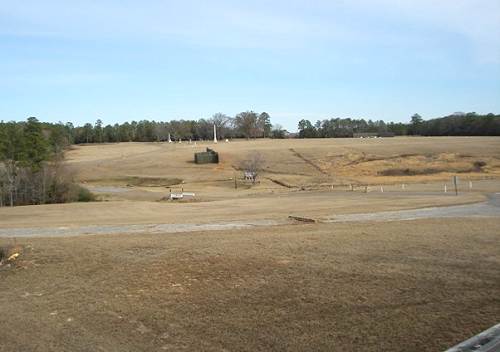
01 Andersonville Prison - Looking North
Because of inability to transport food and other supplies due to supply routes
being cut off by Union forces in addition to severe overcrowding due to absence of
alternative prison camps, conditions at the prison camp deteriorated, especially during
the last part of 1864 and early 1865. Disease and starvation killed some 14,000 Union soldiers during the
time the prison camp was in operation.
My interest in stopping to tour the site which is now managed by the U.S. Park
Service was inspired by the fact that a well known Miller County farmer, George Washington
Edwards (photo 03), was one of the
prisoners interred there for six months in 1864.
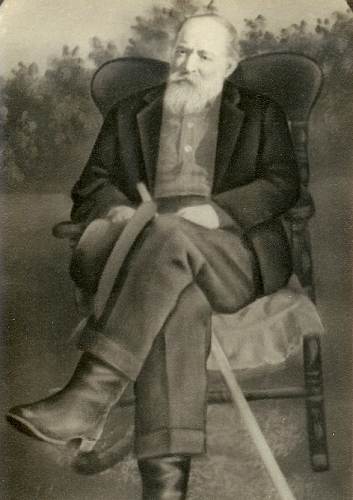
03 George Washington Edwards
You can read more about George Edwards and his family on our own website at:
www.millercountymuseum.org/people/bio_e.html
Next click on "E" in the alphabetical bar at the top of the page and then
scroll down the page until you reach the articles about George Edwards. These articles
were written by Doris Edwards Wyrick, his granddaughter, and by Karen Wyrick Smith, his
great granddaughter.
Upon entering the administration building at the AndersonvilIe prison site I was
offered the opportunity to confirm that George Edwards indeed had been a prisoner there in
1864 because the Park Service has on computer all the prisoners who were sent there as
well as a complete record of all who died there. The computer very quickly came up with
the name of George Washington Edwards of Ohio (from where George originally came).
After touring the prison site and learning about the inhuman conditions which the
prisoners suffered I was amazed that George Edwards was able to survive his stay at the
prison, especially since he was imprisoned for six months. I do need to mention that the
museum guide at Andersonville emphasized some Union prison sites had mortality rates
almost as severe as Andersonville, but Andersonville was the worst. Before taking a
photographic tour of the prison camp I am inserting here a summary of the history of
Andersonville taken from the following website:
www.nps.gov/seac/histback.htm
"In November of 1863, Confederate Captain W. Sidney Winder
was sent to the village of Andersonville in Sumter County, Georgia, to assess the
potential of building a prison for captured Union soldiers. The deep south location, the
availability of fresh water, and its proximity to the Southwestern Railroad, made
Andersonville a favorable prison location. In addition, Andersonville had a population of
less than 20 persons, and was, therefore, politically unable to resist the building of
such an unpopular facility. So Andersonville was chosen as the site for a prison that
would later become infamous in the North for the thousands of prisoners that would die
there before the war ended.
After the prison site was selected, Captain Richard B. Winder was
sent to Andersonville to construct a prison. Arriving in late December of 1863, Captain
Winder adopted a prison design that encompassed roughly 16.5 acres which he felt was large
enough to hold 10,000 prisoners. The prison was to be rectangular in shape with a small
creek flowing roughly through the center of the compound. The prison was given the name
Camp Sumter.
In January of 1864, slaves from local farms were impressed to fell
trees and dig ditches for construction of the prison stockade. The stockade enclosure was
approximately 1010 feet long and 780 feet wide. The walls of the stockade were constructed
of pine logs cut on site, hewn square, and set vertically in a wall trench dug roughly
five feet deep. According to historical accounts, the poles were hewn to a thickness of
eight to 12 inches and "matched so well on the inner line of the palisades as to give
no glimpse of the outer world" (Hamlin 1866:48-49). A light fence known as the
deadline was erected approximately 19-25 feet inside the stockade wall to demarcate a
no-man's land keeping the prisoners away from the stockade wall. Anyone crossing this line
was immediately shot by sentries posted at intervals around the stockade wall.
Included in the construction of the stockade were two gates
positioned along the west stockade line. The gates were described in historic accounts as
"small stockade pens, about 30 feet square, built of massive timbers, with heavy
doors, opening into the prison on one side and the outside on the other" (Bearss
1970:25). Each gate contained wickets (door-sized entryways).
Prisoners began arriving at the prison in late February of 1864
and by early June the prison population had climbed to 20,000. Consequently, it was
decided that a larger prison was necessary, and by mid-June work was begun to enlarge the
prison. The prison's walls were extended 610 feet to the north, encompassing an area of
roughly 10 acres, bringing the total prison area to 26.5 acres. The extension was built by
a crew of Union prisoners consisting of 100 whites and 30 African Americans in about 14
days. On July 1, the northern extension was opened to the prisoners who subsequently tore
down the original north stockade wall, then used the timbers for fuel and building
materials. By August, over 33,000 Union prisoners were held in the 26.5 acre prison.
Due to the threat of Union raids (Sherman's troops were marching
on Atlanta), General Winder ordered the building of defensive earthworks and a middle and
outer stockade around the prison. Construction of the earthworks began July 20th. These
earthworks consisted of Star Fort located southwest of the prison, a redoubt located
northwest of the north gate, and six redans.
The middle and outer stockades were hastily constructed of unhewn
pine logs set vertically in wall trenches that were about four feet deep. The middle
stockade posts projected roughly 12 feet above the ground surface and encircled the inner
prison stockade as well as the corner redans. The outer stockade, which was never
completed, was meant to encompass the entire complex of earthworks and stockades. The
posts of the outer stockade extended about five feet above the ground surface.
By early September, Sherman's troops had occupied Atlanta and the
threat of Union raids on Andersonville prompted the transfer of most of the Union
prisoners to other camps in Georgia and South Carolina. By mid-November, all but about
1500 prisoners had been shipped out of Andersonville, and only a few guards remained to
police them. Transfers to Andersonville in late December increased the numbers of
prisoners once again, but even then the prison population totaled only about 5000 persons.
The number of prisoners at the prison would remain this low until the war ended in April
of 1865. During the 15 months during which Andersonville was operated, almost 13,000 Union
prisoners died there of malnutrition, exposure, and disease; Andersonville became
synonymous with the atrocities which both North and South soldiers experienced as
prisoners of war.
After the war ended, the plot of ground near the prison where
nearly 13,000 Union soldiers had been buried was administered by the United States
government as a National Cemetery. The prison reverted to private hands and was planted in
cotton and other crops until the land was acquired by the Grand Army of the Republic of
George in 1891. During their administration, stone monuments were constructed to mark
various portions of the prison including the four corners of the inner stockade and the
North and South Gates."
Even after enlarging it for a maximum of 20,000 prisoners, more than 33,000
prisoners were forced to crowd together, a situation which led to disease and because of a
shortage of food, inanition, starvation and death. On a tour of the prison camp one can
stop at several important sites where signs are present with diagrams and narratives.
The prisoners were brought into the camp on the North at the North Gate. The Command Post was to the
South located on a slightly elevated area. This gave the Commander, Captain Henry Wirz, opportunity to observe the entire camp with full
perspective. Sentries were
posted every 100 feet along the top of the stockade walls at locations called "Pigeon
Roosts." New arrivals
were shocked at the depraved conditions to which they were to be exposed.
The prison hospital was nothing more than a place to die. Escape attempts were attempted
by tunneling. However, only
three hundred escapes were recorded, almost all by prisoners who were working outside the
prison, a rare circumstance. Prisoners had to provide their own shelters (called
"Shebangs"); no
buildings were built to provide shelter.
The creek which ran through the camp, called Stockade Creek, was
insufficient to supply enough water for the prisoners causing dehydration and because of
lack of flow, the water became stagnant and contaminated leading to further illness.
Prisoners desperately began digging for water and if found would guard it closely or sell
it. Dying of dehydration became the predominant cause of death next to starvation and
disease. Prayers desperately were offered asking for rain, and one night, rain did come.
Thousands of starving thirsty prisoners witnessed something that became one of the
persevering memories of all who were imprisoned as well as the Confederate guards
themselves; for suddenly a lightning bolt came down from the sky and struck the ground
near the southern boundary of the camp creating a large hole from which sprung an artesian
fountain of water, enough to more than supply the thirty some thousand prisoners present. This miraculous event is one of
the enduring stories of Andersonville for which purpose a monument was constructed in the
early part of this century which was located over the spring which still runs to this day (photo 16).
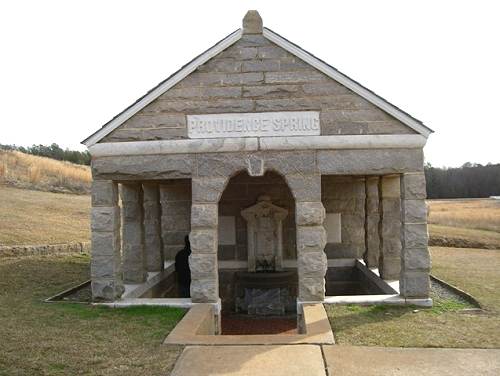
16 Providence Spring Memorial
George Edwards was present at Andersonville the night of the lightning bolt which
opened the ground and let the spring water escape. Mr. Edwards' obituary records the fact
that, indeed, he was one of those prisoners who were there the night of the creation of
the spring (photo 17 of obituary). The
availability of fresh water in abundance undoubtedly saved many lives.
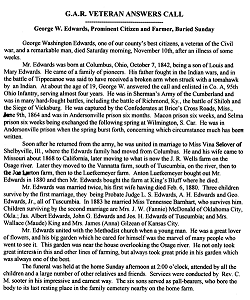
17 George Edwards Obituary
Click photo for larger view
Captain Henry Wirz,
officer in charge of Andersonville, was tried and hanged in Washington D.C. in 1865.
The trial was very controversial since many witnesses gave testimony that Wirz
tried as best he could to improve conditions at the prison camp. Others, however, severely
criticized him. Also, as mentioned above, some Union prison camps had similar conditions
to Andersonville. However, the Andersonville prison camp was considered by most observers
to have been the most egregious example of all the prison camps of the Civil War, North or
South.
Regarding the burial of those who died at Andersonville briefly mentioned above,
because so many were dying so rapidly, mass burials were performed laying the bodies side
by side with only a stake in the ground at the head with the prisoner's identification
number; no names were recorded at the burial site. The names of these prisoners would have
been lost forever were it not for the heroic efforts of Dorence Atwater, one of the prisoners who worked
in the hospital who carefully recorded the name of each and every one of the prisoners who
died and were buried at Andersonville, putting the names alongside the identification
numbers.
He secretly kept the list until after the war when he made known its presence. Without this list the current cemetery at Andersonville could never have been renovated
as a memorial because the names of those buried at each gravesite would never have been
known. You can view some photos of the cemetery at the following website:
www.flickr.com/photos/80297647@N00/206779191/in/set-72157594283817210/
Karen Wyrick Smith one of our regular museum volunteers who has donated much of her
free time helping us renovate and organize the museum, is a great granddaughter of George
Edwards. She has researched much of the Edwards' family history, some of which is on our
website to which I referred earlier in this narrative. Karen has a photocopy of an article
about her great grandfather's experience at Andersonville originally printed in the Miller
County Autogram in October of 1922 which I copy below (photo 20). You may need to use the magnifier device on your
computer to read it with greater facility.
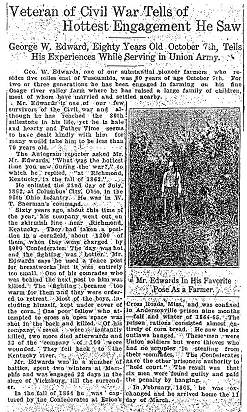
20 George W. Edwards Newspaper Article
Click photo for larger view
One interesting document regarding George Edwards' experience as a Union soldier
was recorded by a medical officer in regard to a clerical error which led to a temporary
but erroneous order to declare Mr. Edwards AWOL. The medical officer wrote an explanation
of the error which exonerated Mr. Edwards (in spite of numerous spelling errors by the
officer!). Karen Wyrick Smith, great granddaughter of Mr. Edwards, found the document in
some old files and it is copied here (photo 21).
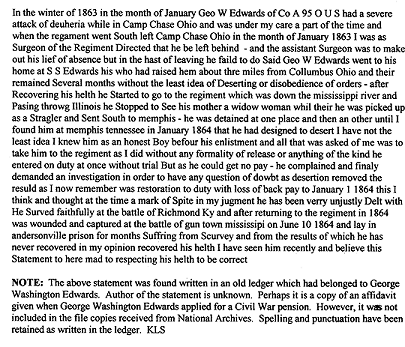
21 George Edwards Civil War Document
Click photo for larger view
I was very impressed by the quality of the National Park Service's management and
presentation of the Andersonville Prison museum and cemetery. I believe that a visit to
this historical site is well worth the effort if one wants to really understand the
tragedy of our country's war against itself nearly a century and half ago. Only
approximately 250 Missouri citizens were prisoners at Andersonville. Although George
Edwards was originally from Ohio, his adult life was predominately lived in Miller County
Missouri and we are proud to record his heroic story for the historical record on our
website.
We were saddened to learn of the passing of Judson Berry (photo 22) of Jefferson City last Thursday, January 31. Judson was a native of Tuscumbia who worked for many years in Washington D C. for the National Security Agency. He and his wife, Mary Lou, moved back to this area in 1985. My wife Judy and I knew him, his siblings and his parents very well. Judson was an active supporter of the Tuscumbia schools, community and especially the Miller County Historical Society.
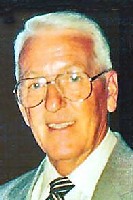
22 Harry Judson "Jud" Berry
You can read his obituary at the Find a Grave website:
https://www.findagrave.com/memorial/54794421/harry-judson-berry
That’s all for this week.
| 


